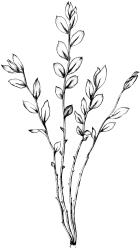The following generic description draws on material in Shaw (1994).
Plants very small to medium-sized, pale- to brown-green to reddish, ± complanate, lustrous or dull. Stems erect or reclining, often horizontal from a vertical substrate, often much branched at base, sometimes unbranched, with a distinct central strand in N.Z. species, with sparse rhizoids restricted to near base. Leaves mostly dimorphic (monomorphic in N.Z. species), the lateral leaves in 2–3 rows, obovate to broadly elliptic, acute (sometimes broadly so) to acuminate, scarcely altered when dry, sometimes decurrent; reduced dorsal leaves often present in 1–3 rows and narrowly to broadly lanceolate; leaf margins plane, entire to weakly serrate or crenulate near apex; laminal cells prosenchymatous, large, lax, and thin-walled, broadly rhombic to linear, narrowed at margins to form a border; costa weak, extending (⅓–)½–⅔ the length of the lateral leaves, often red, usually shorter in dorsal leaves.
Dioicous. Perichaetia terminal, with perichaetial leaves similar to vegetative leaves or longer and narrower. Perigonia terminal and bulbiform. Setae elongate; capsules inclined, short cylindric or pyriform; exothecial cells collenchymatous; annulus differentiated; operculum convex to conic; peristome well-developed and bryoid, with nodulose cilia.
The gametophytes of most species of Epipterygium are characterised by having usually complanate and dimorphic, more or less elliptic leaves arranged in a 2/5 phyllotaxy. The plants usually have red pigments, laxly rhomboidal (prosenchymatous) leaf cells, weak costae, and more or less distinctly bordered leaves (Fife & Shaw 1990). The relatively short costae help distinguish it from Pohlia.
Shaw (1984) described the species of Epipterygium as "essentially uniform" in sporophyte morphology and noted that the "uniformity of the sporophytes lends cohesion to a genus of considerable gametophytic variability." Sporophytes are rare in most species of Epipterygium, which are apparently all dioicous.
Epipterygium is primarily a tropical genus, with a centre of diversity in, and near, Central America, but also occurring in tropical Africa and Asia. Its occurrence in temperate regions of the northern hemisphere (notably in western North America, Britain, and scattered localities in continental Europe, the Caucasus, the Himalayas, and Japan) is due to the wide range of one species, E. tozeri (Grev.) Lindb., which is the best known species. Epipterygium opararense is the only member of the genus recorded from the temperate southern hemisphere.
Shaw & Ramsay (2013) recently published their opinion that Epipterygium, together with Pohlia and Mielichhoferia, should be isolated into the segregate family Mielichhoferiaceae. As rationale for this family, they cite molecular studies by Cox & Hedderson (2003).
| Category | Number |
|---|---|
| Indigenous (Endemic) | 1 |
| Total | 1 |




